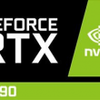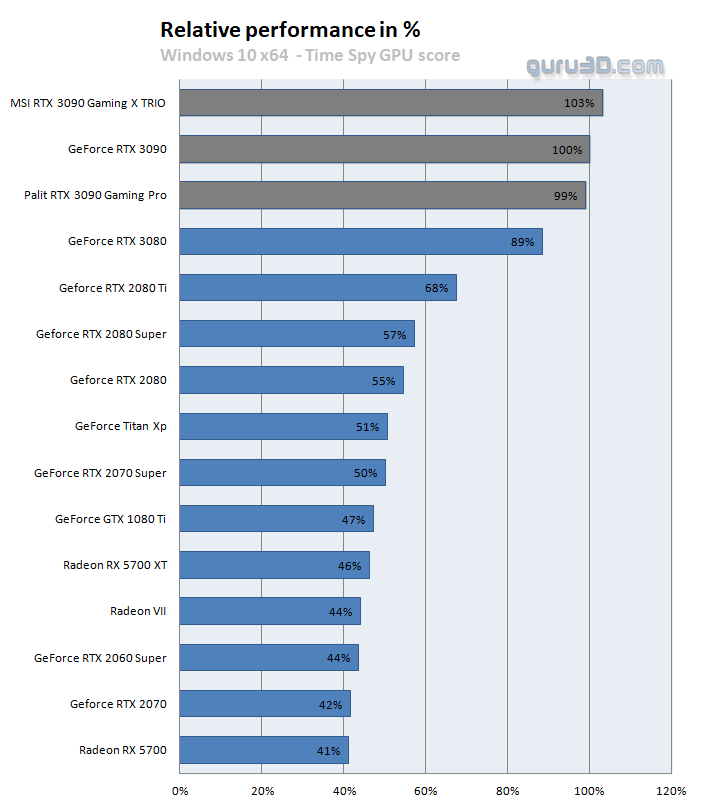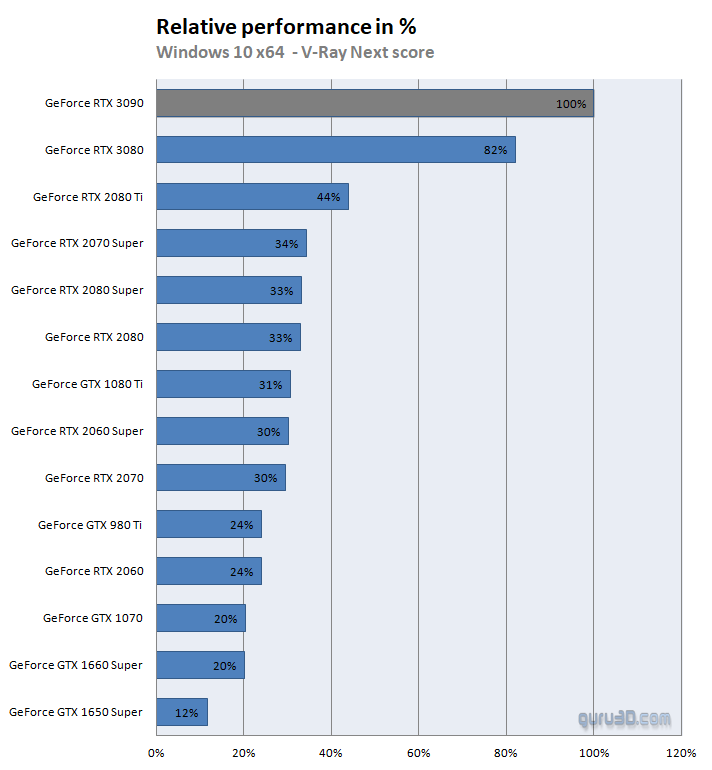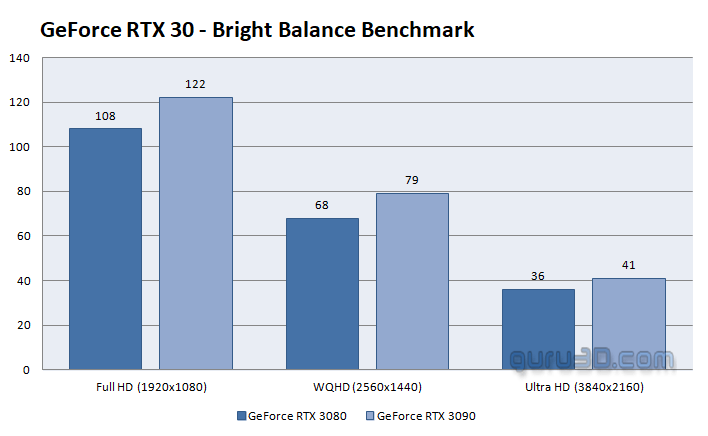Final words and conclusion
Final words
When we had our first experience with the GeForce RTX 3080, we were nothing short of impressed. Testing the GeForce RTX 3090 is yet another step up. But we're not sure if the 3090 is the better option though, as you'll need very stringent requirements in order for it to see a good performance benefit. Granted, and I have written this many times in the past with the Titans and the like, a graphics card like this is bound to run into bottlenecks much faster than your normal graphics cards. Three factors come into play here, CPU bottlenecks, low-resolution bottlenecks, and the actual game (API). The GeForce RTX 3090 is the kind of product that needs to be free from all three aforementioned factors. Thus, you need to have a spicy processor that can keep up with the card, you need lovely GPU bound games preferably with DX12 ASYNC compute and, of course, if you are not gaming at the very least in Ultra HD, then why even bother, right? The flipside of the coin is that when you have these three musketeers applied and in effect, well, then there is no card faster than the 3090, trust me; it's a freakfest of performance, but granted, also bitter-sweet when weighing all factors in.
Performance
Right, I kinda spilled the beans already in the previous paragraph, but ultimately it is all about that, gaming performance and, of course, rendering quality. Of course, the GeForce RTX 3090 is a product that does not need to make sense and cannot disappoint in that department, albeit we feel the RTX 3080 obviously offers more value for money. As mentioned, you need to feed the card what it needs, a GPU bound game preferably at Ultra HD. NVIDIA claims this card is even capable of running games at 8K, that however is something we cannot objectively test. At Full HD you'll be quite often bottlenecked and CPU limited. But even there, in some games with proper programming and the right API (DX12/ASYNC compute), the sheer increase in performance is breathtaking. The good old rasterizer engine rips right through the threshold of extreme performance, all thanks to the 10.4K Shading processors.
Performance-wise we can safely state that this is a true Ultra HD capable graphics card, which it should be at this retail price. But whether or not you use traditional rendering or games that can be ray-traced and manage DLSS, it's all coming together in that UHD resolution. Battlefield V with ray-tracing and DLSS enabled, in Ultra HD now running in that 86 FPS bracket. DX-R ray-tracing and Tensor performance; the RTX 30 series has received new Tensor and RT cores. So don't let the actual RT and Tensor core count confuse you. They're located close inside that rendering engine, they became more efficient and that shows. If we look at an RTX 2080 with Port Royale, we will hit almost 30 FPS. The RTX 3090 doubles that at over 60 FPS. Tensor cores are harder to measure, but overall from what we have seen, it's all in good balance. Overall though, the GeForce RTX 3080 starts to make sense starting at a Quad HD resolution (2560x1440), the RTX 3090 Ultra HD at 3840x2160, it is that simple. Games like Red Dead Redemption 2 will make you trigger happy at close to 80 FPS in UHD resolutions with the very best graphics settings. As always, comparing apples and oranges, the performance results vary here and there as each architecture offers advantages and disadvantages in certain game render workloads.
The result sets of compute performance, content creation remains baffling to me. Not necessarily comparing 3080 and 3090, but the step from last-gen series 20 towards series 30 has been nothing short of amazing. The RTX 3090 is three times faster than an RTX 2080 and more than twice as fast as the RTX 2080 Ti. As you have been able to see, the content creation scene is gonna be happy with the Ampere architecture overall as well, applications like Blender and VRAY tear a new hole in performance, absolutely staggering to see and observe. What need I say and state more about performance, you have all the evidence you need in our extensive benchmark suite.
Cooling & noise levels
The new cooling design looks awesome and, pardon the pun, 'it just works'. It has made the product 'overall' quieter. The RTX 3090 is a next-level product and it has a brutally severe power consumption, you'll close in at a TDP of 375 Watts for this product under full load, and TDP directly relates to the output heat of your product, there is heaps of it ditched inside your chassis. In extremely stressed conditions, we did hit 39 dBA though it took a while for the card to get there (warms up slowly), but still, even that is considered a normal acoustic level. Depending on the level of airflow inside your chassis, expect the card to sit in the 70, maybe 75 Degrees C range temperature-wise under hefty load conditions (depending on the airflow in your chassis). As FLIR imaging shows, the top side of the card shows slight heat bleeding though not as significant as we have seen on the RTX 3080 FE.
Energy
In the previous paragraph, I already mentioned this; your heat output and energy consumption are always closely related to each other as (graphics) processors and heat can be perceived as a 1:1 state, 100 Watts in (consumption) often equals 100 Watts of heat as output. This is the basis of TDP. NVIDIA is listing their TGP at 350 Watts, which is staggering for a graphics card in the year 2020. The base products in our measurements will indeed sit at that level, but the total board power can even exceed that value with faster OC model AIB cards reaching 380 Watts, perhaps even closer to 400 Watts, these are stupendous amounts of energy which we feel are values that should not be taken for granted lightly. So we're certainly not happy with the new energy consumption values as it is not a trend that suits my comfort zone, really that value was up-to 250 Watts.
Coil whine
Much like the 3080, the GeForce RTX 3090 does exhibit coil squeal. Is it annoying? It's at a level you can hear it. In a closed chassis, that noise would fade away in the background. However, with an open chassis, you can hear coil whine/squeal. Graphics cards all make this in some sort or form, especially at high framerates this can be perceived.
Pricing
NVIDIA is pricing the GeForce RTX 3090 at USD 1499. It's an inordinate amount of money for something to play PC games on. This product is so exclusive that it creates its own niche. NVIDIA likely could have even priced the product higher and they'd still sell. Hey, and here's a shocker, we expect AIB cards to be even more expensive. Compared to the GeForce RTX 3080, the price-performance ratio is off, period. Now, I can make all kinds of barbarous comments about it, but these products will sell indifferently and without hesitation.
Cons
Ehm yes, price. Of course. Then power consumption, which has risen significantly over Turing, we feel it's too much really. The 12-pin adapter cable is a bit of a nagging thing, I do not like it with the adapter; sure the new PCIe PEG power connector works really well. It's a more gentle and subtle solution. It will however only look nice if you have a proper dedicated 12-pin power cable coming from the PSU and PSU manufacturers are working on that. The problem with the current adapter cable is that it's relatively short, so it is not easy to hide. The cooler design then, no matter how I look at it, in a year these black fins will catch some dust. Also, if you mount your graphics card horizontally, hot air will be blowing towards the CPU and VRM area. Not an issue per se, but with a chassis that exhibits poor airflow and a heat pipe cooled processor, this does raise a bit of a red flag. If you are uncomfortable with that, a custom AIB card probably is something for you to look out for.
Ray-tracing
So what is the state of hybrid ray-tracing combined with rasterized Shading? Well, with the RTX 2000 series, NVIDIA was pioneering and they ran into snags mostly found in performance. Still, titles like Battlefield V have been playable in the somewhat lower resolutions with RTX enabled. The good news is that DX-R performance seems to have almost doubled and, while it's still not extremely fast, it should be fast enough for most titles in Full HD, Quad HD and even some in Ultra HD, especially with DLSS 2.0 applied things look fantastic. Ray-tracing is a trend, you'll see it on the new 2020 consoles and you'll also see it from competing products. Not because it's RTX, no, because Microsoft added DirectX ray-tracing. It is the future of game rendering and in the coming years, things should start to take off. I want to show you the following video I recorded:
Above, you can see the new Bright Memory RTX Benchmark. Bright memory is an indie game release in development and has added ray-traced reflections and NVIDIA DLSS. It is built on the Unreal Engine 4 and combines the ranged shooting style of a traditional FPS, with quick-paced combo attacks from melee skills and close-range abilities typically found in action titles. Since this is an RTX showcase, we cannot use it as a benchmark. But it does bring an example of what's possible. We enabled RTX and the Very High settings (highest) and DLSS at its best Quality modus. Here are the results:
Please relate FPS to what you just observed in the video. Try to imagine gaming like that; yes we're still not there FPS wise in Ultra HD. But we have more cards to test and the future does look bright, as that is just staggering to see. BTW YouTube immediately claimed a copyright issue after uploading, any ads are of the claimer (we don't enable ads ourselves for YT videos). That's the future of game render quality. And sure, I know it is a showcase, ergo we have not included it in the benchmarks suite. Just trying to make a point here.
Tweaking
Tweaking Ampere GPUs has been a bit of a challenge. Sometimes puzzling, other times easy. The tweaks on the clock frequency and memory run fine, but the performance was just often lower than defaults. There is a new safety protection active on memory, which will prevent the card from crashing when clocked too far, it, however, will drop in performance. For the RTX 3090 series we'd expect you to add and reach +250 max with a steady 20 Gbps of effective bandwidth. Of course, increase the power limiter to the max so your GPU gets (even) more energy budget and then the GPU clock can be increased anywhere from +25 to +75MHz. Why this huge differential you might wonder? Well, results will vary per board, brand and even card due to cooling (GDDR6X/GPU/VRM), but also ASIC quality. In the end I expect 20, however, if you are lucky, 20.5 Gbps on the memory subsystem (effective) and let me be subtle; a +50 Core frequency and added power, you should see your card hovering at the 2 GHz range (which is pretty awesome). I will say this though, frequency matters LESS these days. Even if the GPU could do 2100 MHz, your power limiter will be the decisive and dominant factor, lowering that clock frequency to meets its assigned power budget.
Conclusion
NVIDIA's Ampere product line up has been impressive all the way, there's nothing other to conclude than that. Is it all perfect? Well, performance-wise in the year 2020 we cannot complain. Of course, there is an energy consumption factor to weigh in as a negative factor and, yes, there's pricing to consider. Both are far too high for the product to make any real sense. For gaming, we do not feel the 3090 makes a substantial enough difference over the RTX 3080 with 10 to 15% differentials, and that's mainly due to system bottlenecks really. You need to game at Ultra HD and beyond for this card to make a bit of sense. We also recognize that the two factors do not need to make sense for quite a bunch of you as the product sits in a very extreme niche. But I stated enough about that. I like this chunk of hardware sitting inside a PC though as, no matter how you look at it, it is a majestic product. Please make sure you have plenty of ventilation though as the RTX 3090 will dump lots of heat. It is big but still looks terrific. And the performance, oh man... that performance, it is all good all the way as long as you uphold my three musketeers remark. Where I could nag a little about the 10 GB VRAM on the GeForce RTX 3080, we cannot complain even the slightest bit about the whopping big mac feature of the 3090, 24 GB of the fastest GDDR6X your money can get you, take that Flight Sim 2020! This is an Ultra HD card, in that domain, it shines whether that is using shading (regular rendered games) or when using hybrid ray-tracing + DLSS. It's a purebred but unfortunately very power-hungry product that will reach only a select group of people. But it is formidable if you deliver it to the right circumstances. Would we recommend this product? Ehm no, you are better off with GeForce RTX 3070 or 3080 as, money-wise, this doesn't make much sense. But it is genuinely a startling product worthy of a top pick award, an award we hand out so rarely for a reference or Founder product but we also have to acknowledge that NVIDIA really is stepping up on their 'reference' designs and is now setting a new and better standard.
Sign up to receive a notification when we publish a new article.
Or go back to Guru3D's front page
- Hilbert, LOAD"*",8,1.





